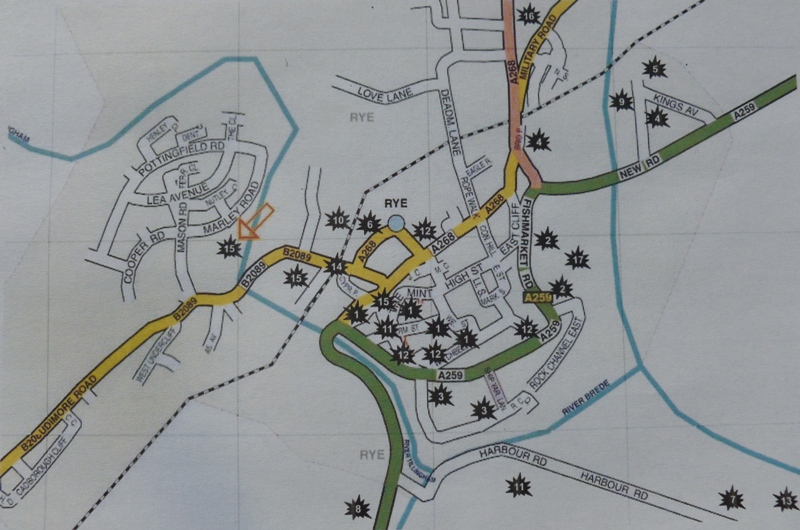Memories become history when no one who was there at the time remains alive, so Rye is recalling the start of world war one as history this year – but the Arts Festival was still pulling together memories of world war two on organised walks round the town, which included some who could still say “I remember” – and for whom it was not yet history, but half-recalled childhoods.
Thinking of Rye as a war zone is hard, 70 plus years after the events of 1940-1945, but Rye was targeted 17 times, by bombs as well as flying bombs (which we now think of as cruise missiles) and machine gun strafing – and the bomb map’s pattern suggests the railway line and Strand harbour were particular targets. Other nuggets from the Arts Festival’s guided tour of world war two in Rye included:
- Rye Harbour’s position on the invasion front line where the caravan site lies between an 18th century Martello tower (to keep out Napoleon) and 20th century pillboxes (to stop Hitler) and the whole holiday park was in the middle of a giant minefield alongside flooded areas towards Pett where the sea wall had been demolished. However the large rabbit population suggests the mines have all been safely removed.
- Plans for the Germans’ “Operation Sealion” included landing a Panzer regiment, two mountain regiments and two infantry regiments between Camber and Fairlight – who would bypass Rye and head rapidly inland towards Broad Oak and Robertsbridge.
- Artist Edward Burra, better known for his allegedly louche life and cafe paintings in the 30s, was here throughout the war, grew onions (as French supplies dried up) and painted (amongst other wartime images) the bombing of the radar station near the power lines from Dungeness. The area played a major part in both the Battle of Britain in 1940 and in the defence against incoming doodlebugs (flying bombs).
- Possible bullet holes in a garden wall in Watchbell Street where an anti aircraft gun was reputedly sited on the edge of the cliff facing seawards.
- Leaflets issued in case of invasion which said “Do not give any German anything”. However a German spy in Lydd who wanted a pint of beer at 9 o’clock on a Sunday morning got more than he wanted. Imprisonment and execution.
- Thousands of flying bombs passed directly overhead on their way to London, and there is a picture of one now on the front door of former mayor Frank Palmer’s house in the Strand – which itself is on the site of a house destroyed during the war – and is now under threat today, but instead by unsteady trees overhead.
- And for all those who remember the late, great Dickie Attenborough in the film “Dunkirk”, all the evidence seems to be that local boat owners did not cross the Channel over to Dunkirk from Ramsgate. Navy personnel did. But possibly they did from other departure points, though no evidence exists – yet.
- And, last but not least, people sheltering in a cellar in Wish Ward got a nasty surprise when a bomb landed in the middle of them. But it failed to explode.
The bomb damage map was compiled from the minutes of the Emergency Sub-committee of Rye Borough Council.
The information was obtained from “A timeline for Rye” compiled by Peter Mackenzie Smith



